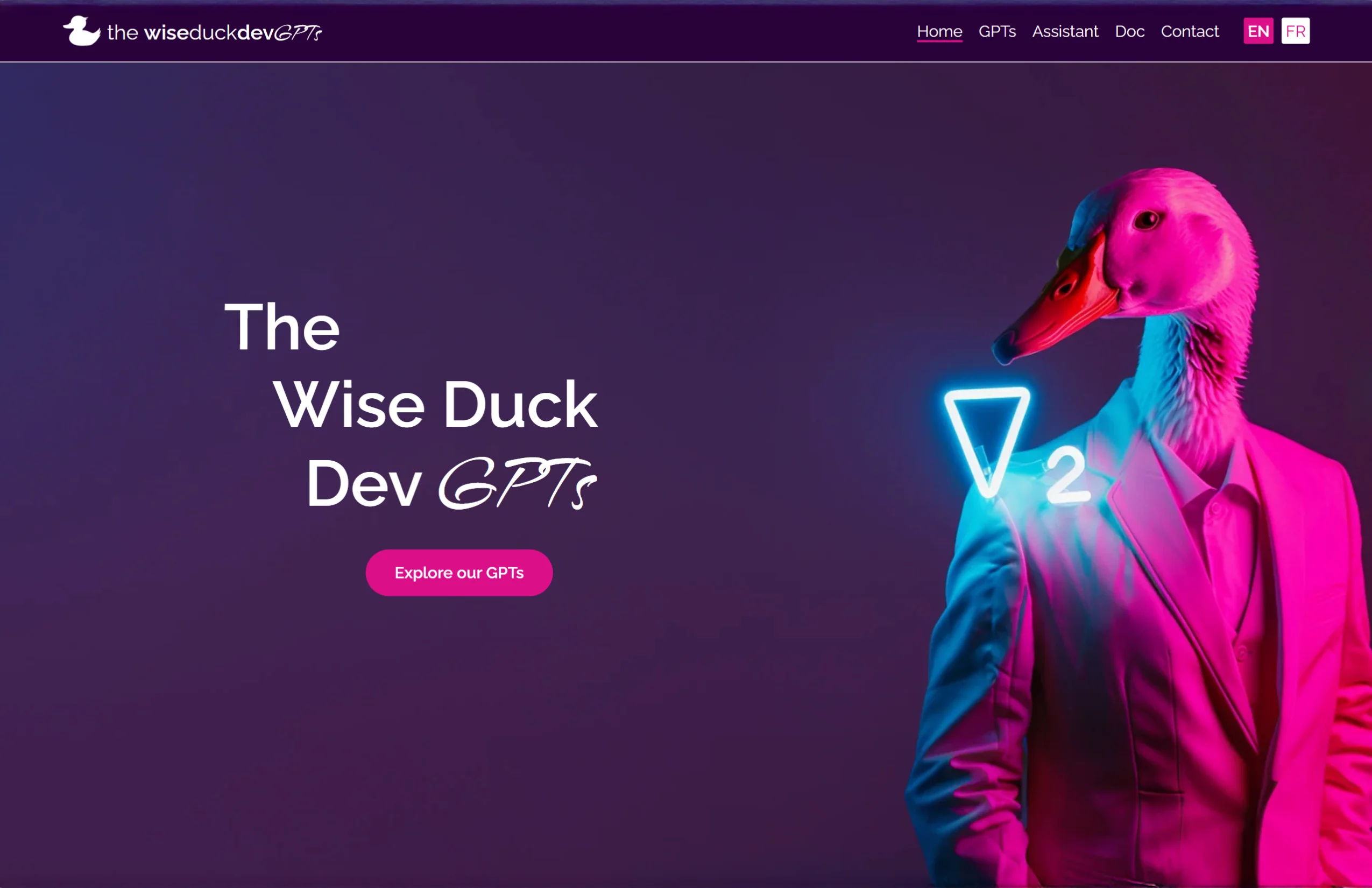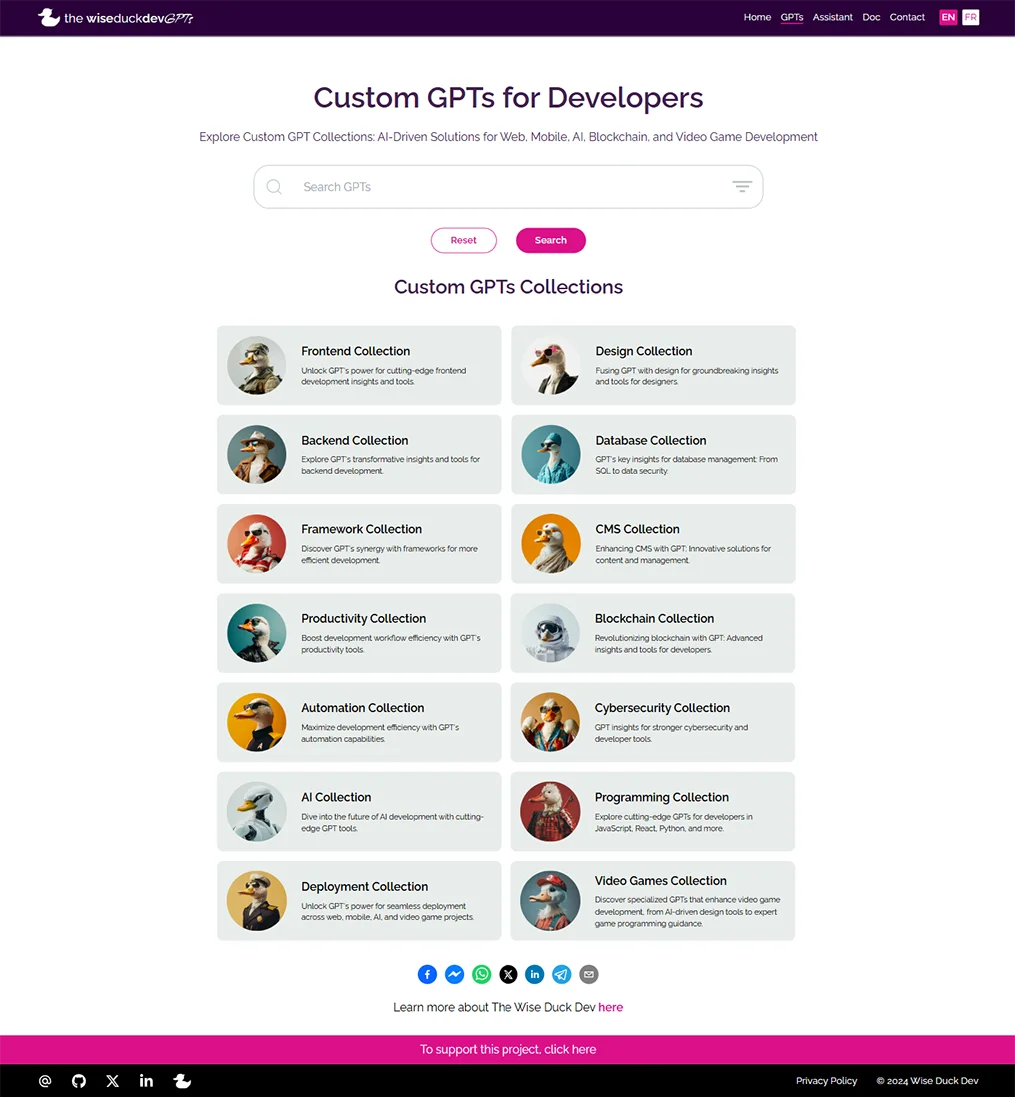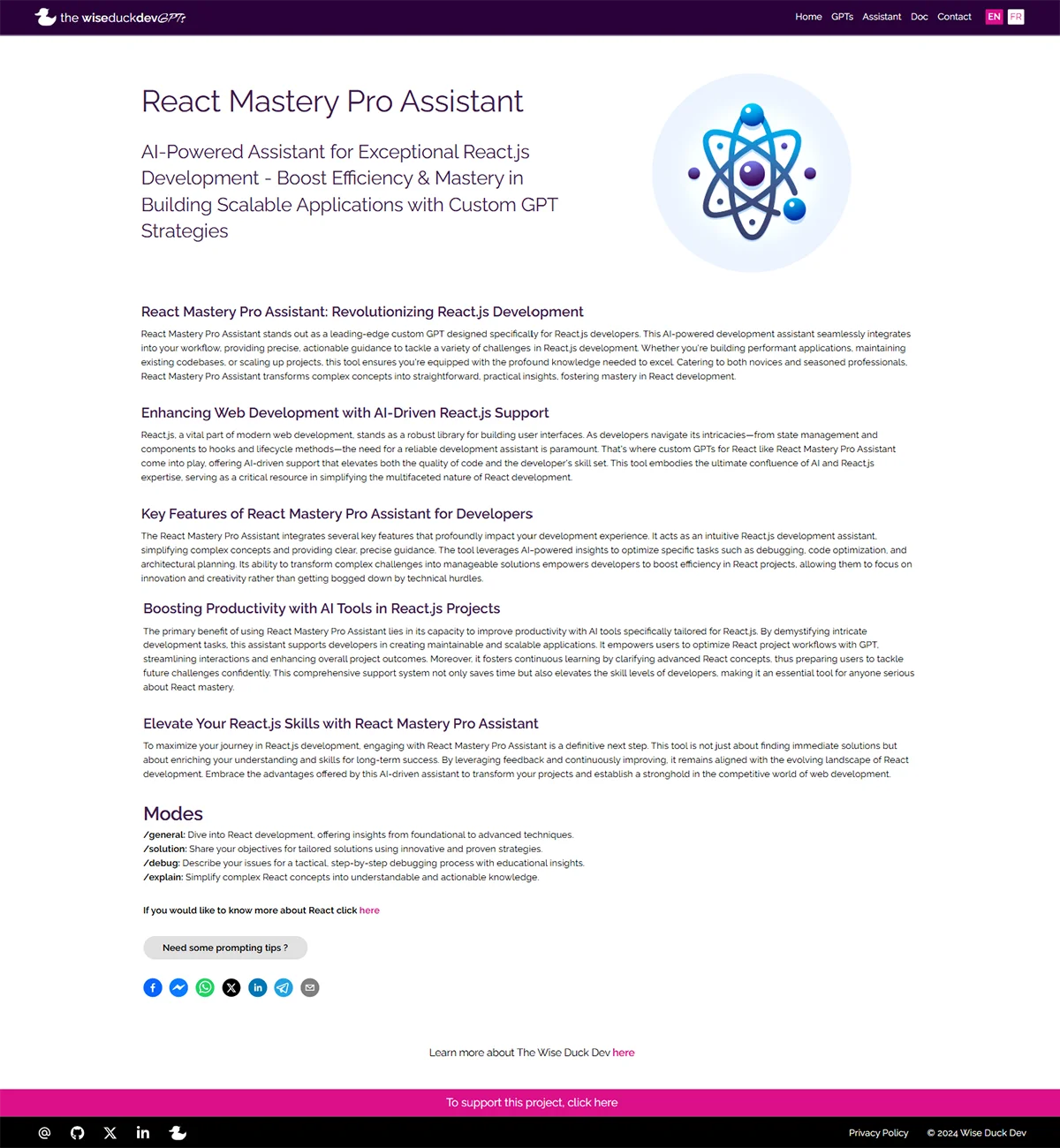
Loading
the wiseduckdev


the wiseduckdev
Wise Duck Dev GPTs
Discover Wise Duck Dev GPTs — a platform hosting over 800 AI-powered custom GPTs built for developers across web, mobile, AI, blockchain, and gaming. A project born from curiosity, crafted for innovation.
ROLE
- Product Manager
- Full-Stack Developer
- AI Engineer
- Automation Engineer
- DevOps & SEO Specialist

AI-Powered Custom GPT Ecosystem for Developers
In 2024, I launched Wise Duck Dev GPTs, a groundbreaking platform offering over 800 custom GPTs tailored for developers. Born from my journey as a newly certified developer, this project evolved from a personal portfolio idea into a vibrant resource, empowering coders with AI-driven productivity tools.
Project Overview
Wise Duck Dev GPTs is a revolutionary platform delivering advanced custom GPTs designed for web, mobile, AI, blockchain, and video game developers. With over 800 specialized GPTs, it boosts productivity, enhances code quality, and simplifies complex tasks. Leveraging cutting-edge AI technologies, the platform not only helps complete projects efficiently but also serves as a technology repository for exploring new tools. Whether you’re building AI models, web apps, or blockchain solutions, Wise Duck Dev GPTs is your partner in pushing boundaries.
The idea for the platform came right after I completed my developer certification. I wanted to build a portfolio that truly reflected who I was, something original, useful, and personal. During my time at O’clock, I had created several custom GPTs to help me learn and code more efficiently. They made such a difference in my workflow that I thought: why not share them with others? What started as a small personal library of 10-15 GPTs quickly grew. By the summer of 2024, the platform hosted over 250 tools (Version 1), and by early 2025, that number had soared to more than 800 (Version 2). Each GPT is crafted to support developers in web, mobile, AI, blockchain, and gaming, helping them code faster, solve problems smarter, and boost their creativity.
My Role
This was a solo project, meaning I handled everything from idea to launch, across design, development, AI, and automation.
- Product Manager: I imagined the entire user experience, from how developers would browse GPTs to how each section should feel. I structured the app’s features, interface flow, and content to make everything intuitive and developer-friendly.
- Technical Architecture: I built the foundation of the app with scalability and automation in mind, using a modular approach that supports innovation and future iterations.
- Full-Stack Developer: I built the platform using Next.js, TypeScript, and Sass. For data management, I initially started with a simple JSON-based structure, then progressively migrated to a SQL database using Prisma to ensure scalability and reliability. I also integrated Meilisearch to deliver a fast, relevant, and seamless search experience.
- AI Engineer: I designed over 800 custom GPTs by leveraging automated systems that combined the latest AI technologies with advanced prompt engineering techniques. Each GPT follows a structured logic that ensures ecosystem-wide consistency, high-quality responses, and fast, centralized updates when needed.
- Automation Engineer: I used Make.com and OpenAI’s API to automate the creation of the custom GPTs and their bilingual documentation, saving a lot of time and making the platform highly scalable.
- DevOps & SEO Specialist: I optimized the site for search engines and deployed it as a lightning-fast PWA using Vercel, ensuring users have a smooth, mobile-friendly experience.
From ideation to deployment, I led every aspect, blending technical prowess with product strategy.
Creativity & Inspiration
The idea first came to me during a meditation session while I was completing my intensive Web & Mobile Development certification at O’Clock. I was reflecting on the portfolio I would need to build after graduating, and how, despite being a junior developer, I could stand out from the crowd and offer something truly unique to recruiters. That’s when I envisioned what would eventually become the logo of the Wise Duck Dev: a bold, stylized rubber duck seen in profile, almost like a playful nod to the iconic Apple logo.
At first, I laughed. A duck? Really? That’s my big idea? But the more I thought about it, the more it made sense. Ducks are among the few animals that can move seamlessly across air, land, and water, they fly, swim, and walk. That adaptability resonated deeply with me. It perfectly symbolized the versatility of a Full-Stack developer, able to navigate front-end, back-end, and databases with ease. That was the spark: the Wise Duck Dev was born.
A few months later, in November 2023, OpenAI released the Custom GPT feature, and that completely changed the game for me. I began creating specialized GPTs to support my learning in technologies like JavaScript and Next.js, and quickly realized how powerful they could be. Once I graduated and started working on my portfolio, the next step felt obvious: share these tools with the wider developer community. Not just to showcase my skills, but to empower others and help them work faster, better, and smarter.
That’s how the Wise Duck Dev GPTs platform was born, a blend of creativity, innovation, and a genuine desire to elevate other developers through the power of AI.

Process & Strategy
The project initially began as a simple extension of my portfolio (version 1). However, once I envisioned the long-term potential of the project, and its version 2, it became clear that both the technical architecture and the overall business approach needed to be completely rethought.
Drawing on insights from my training at HEC Montréal and O’Clock, I developed a full business model and a SMART strategic roadmap. I clearly defined the core questions: What real needs would this platform address? Who are the target users? What are their expectations, habits, and preferred channels of communication?
With a monetization goal set for 2026 (version 3), I designed a scalable and future-ready platform. I built the new concept using Midjourney and Figma, and followed Agile principles with rapid iterations, testing each version live on Vercel to guarantee a seamless PWA deployment.
Content creation was automated using a custom 40-step Make.com workflow that generated GPTs and their bilingual (English/French) SEO-optimized documentation. Finally, to ensure content quality and alignment with Google’s SEO best practices, I leveraged one of my own custom GPTs specialized in SEO to support the writing process.
Stack and Tooling
- Front-End : React, Next.js, TypeScript, CSS, Sass
- Back-End : Prisma
- Database : PostgreSQL
- AI : OpenAI API, ChatGPT, Midjourney
- Search engine : Meilisearch
- Deployment : Vercel, PWA
- Automatisation : Make.com
- Versioning : Git, GitHub
- Design : Figma
I chose Next.js and Vercel for their free, community-backed deployment platform, which made it easy to launch quickly and reliably. As a junior developer, Make.com helped me automate key processes without deep backend knowledge, though I now code those flows myself. For design, I switched from component libraries like MantineUI (used in Family Flow) to Sass, which gave me full creative control over the UI. I integrated Meilisearch to deliver a fast, Google-like search experience at no cost. Finally, using OpenAI and TypeScript allowed me to build high-quality features while minimizing bugs and runtime errors.
Design and UX Highlights
Showcasing over 800 custom GPTs meant designing a user experience that made exploration easy and enjoyable. I organized the platform into 14 clear categories (like Frontend, AI, or Blockchain), added a powerful Meilisearch-based search bar, and built intuitive navigation with breadcrumb trails. Each GPT is presented as a clean, visual card, featuring logos, concise descriptions, and links to detailed documentation.
Drawing from my 15 years of experience as a restaurant manager, I treated the site like a well-run dining room: everything in its place, easy to find, and designed to keep people coming back.

Deployment & Scalability
The platform was deployed as a Progressive Web App (PWA) via Vercel, supported by a continuous integration and deployment (CI/CD) pipeline ensuring fast and reliable releases. Google Analytics was integrated to provide accurate usage tracking. Today, the platform has over 400 active users and exceeds 10,000 interactions with its GPTs. Its modular and scalable architecture allows new categories to be added seamlessly while sustaining traffic growth without compromising performance.
Roadmap & Vision
- Phase 1 (2024): 250 GPTs, 12 collections, 1,000 users.
- Phase 2 (2025*: 800+ GPTs, 14 collections, 10,000 users, PWA, Ducky AI assistant.
- Phase 3 (2026): 1000+ GPTs, 16 collections, 100,000 users, chat interface.
- Phase 4 (2027/2028): 1,000,000 users, communities.
Some of the possible evolutions we envisioned included:
Outcomes
Version 2 of the platform launched with an initial core of 400 to 500 active users, generating over 10,000 interactions with the GPTs. Feedback was overwhelmingly positive, highlighting the clarity of the interface and the relevance of the tools provided. This project allowed me to strengthen key skills such as software modularity, large-scale automation (notably through Chain of Thought-style reasoning chains), and the design of scalable architectures, all of which now position me to take on higher-impact, large-scale projects.
What I Took Away
This project solidified my capabilities not just as a developer, but as a full-stack product builder with a deep understanding of AI integration.
I learned how to independently scale a complex product from concept to production, designing, developing, and deploying every layer myself. From the initial database schema to the frontend search experience, I took full ownership of the architecture and roadmap.
Through this process, I mastered large-scale prompt engineering. I developed robust systems for structuring GPTs with consistent logic, leveraging advanced chaining techniques to maintain modularity and ensure each GPT remained functional, relevant, and easy to adopt.
Shipping with coherence became a guiding principle. I aligned design, UX, performance, and backend strategy around a unified vision, ensuring that every layer of the platform worked harmoniously together.
I also gained hands-on experience with no-code automation through Make.com, and later on using code, building scalable content workflows that allowed me to maintain and grow a database of over 800 GPTs efficiently. Automation wasn't just a productivity tool, it was a key enabler of platform sustainability.
Beyond development, I built expertise in multilingual SEO. I structured content and meta strategies specifically around how developers search for GPT tools across different languages and intents, ensuring discoverability and relevance at scale.